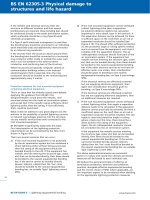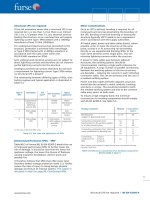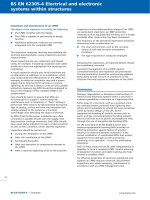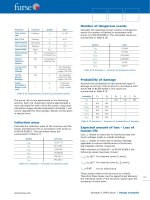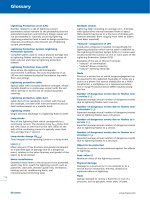Bsi bs en 01993 2 2006 na + a1 2012
Bạn đang xem bản rút gọn của tài liệu. Xem và tải ngay bản đầy đủ của tài liệu tại đây (351.69 KB, 18 trang )
Licensed Copy: Miss Lucie Carter, British Standards Institution, 15/02/2012 12:20, Uncontrolled Copy, (c) The British Standards Institution 2012
NA to BS EN 1993-2:2006
NA+A1:2012
NATIONAL ANNEX
UK National Annex to
Eurocode 3: Design
Design of
of
steel
structures
–
structures
–
Part 2: Steel bridges
ICS 91.010.30; 91.080.10; 93.040
NO COPYING WITHOUT BSI PERMISSION EXCEPT AS PERMITTED BY COPYRIGHT LAW
Licensed
LicensedCopy:
Copy:Miss
MissLucie
LucieCarter,
Carter,British
BritishStandards
StandardsInstitution,
Institution,15/02/2012
15/02/201212:20,
12:20,Uncontrolled
UncontrolledCopy,
Copy,(c)(c)The
TheBritish
BritishStandards
StandardsInstitution
Institution2012
2012
NA+A1:2012
to BS EN 1993-2:2006
NA
to BS EN 1993-2:2006
NA to BS EN 1993-2:2006
Publishing and copyright information
Publishing and copyright information
The BSI copyright notice displayed in this document indicates when the
The BSI copyright notice displayed in this document indicates when the
document was last issued.
document was last issued.
© The
British Standards Institution 2012
©
BSI 2008
©
BSI 2008by BSI Standards Limited 2012
Published
ISBN 978 0 580 54975 5
ISBN978
978 00 580
580 54975
78489 5
7
ISBN
The following BSI references relate to the work on this standard:
The following BSI references relate to the work on this standard:
Committee reference B/525/10
Committee
reference
B/525/10 DC
07/30128148
Draft for comment
Draft for
for comment
comment 07/30128148
07/30128148 DC,
DC 12/30260810 DC
Draft
Publication history
Publication history
First published May 2008
First published May 2008
Amendments issued since publication
Amendments issued since publication
Amd. no.
Amd. no.
Date
Date
Text affected
Text affected
A1
31 July 2012
See Introduction.
Licensed Copy: Miss Lucie Carter, British Standards Institution, 15/02/2012 12:20, Uncontrolled Copy, (c) The British Standards Institution 2012
NA+A1:2012NA
to to
BS
BSEN
EN1993-2:2006
1993-2:2006
Contents
Introduction 1
NA.1
NA.2
NA.3
NA.4
Scope 1
Nationally Determined Parameters 2
Decision on the status of the informative annexes
References to non-contradictory complementary
information 11
10
Bibliography 12
List of tables
Table NA.1 – Additional sacrificial thickness 4
Summary of pages
This document comprises a front cover, an inside front cover,
pages i and ii, pages 1 to 12, an inside back cover and a back cover.
© BSI2012
2008 ã
ã ii
â The British Standards Institution
Licensed Copy: Miss Lucie Carter, British Standards Institution, 15/02/2012 12:20, Uncontrolled Copy, (c) The British Standards Institution 2012
NA+A1:2012
to BS EN 1993-2:2006
NA
to BS EN 1993-2:2006
ii
ii ãã â
â BSI
The2008
British Standards Institution 2012
This page deliberately left blank
Licensed Copy: Miss
Licensed
LucieCopy:
Carter,
Miss
British
Lucie
Standards
Carter, British
Institution,
Standards
15/02/2012
Institution,
12:20,
15/02/2012
Uncontrolled
12:20,
Copy,
Uncontrolled
(c) The British
Copy,
Standards
(c) The British
Institution
Standards
2012 Institution 2012
NA+A1:2012NA
to to
BS
BSEN
EN1993-2:2006
1993-2:2006
National Annex (informative) to
BS EN 1993-2:2006, Eurocode 3 – Design
of steel
NA to BS EN 1993-2:2006
structures – Part 2: Steel bridges
National Annex (informative) to
Introduction
BS EN 1993-2:2006,
Eurocode
3 –by Design
of steel
This National
NationalAnnex
Annexhas
is published
BSI
Standards
Limited,B/525/10,
under
This
been prepared
by BSI
Subcommittee
structures – PartBridges,
2: Steel
bridges
licence
from
The British
Standards
Institution.
Thisuse
National
Annex
in consultation
with B/525/31,
Structural
of steel.
has been prepared by BSI Subcommittee B/525/10, Bridges, in
consultation with B/525/31, Structural use of steel.
The
start and finish of text introduced or altered by National
NA.1 Introduction
Scope
Amendment No.1 is indicated in the text by tags and. Minor
This
National Annex
Annex has
gives:
This
National
been
prepared by BSI Subcommittee B/525/10,
editorial
changes are
not
tagged.
Bridges,
in decisions
consultation
B/525/31,Determined
Structural use
of steel.
a)
the UK
for with
the Nationally
Parameters
National Amendment A1 has introduced changes to NA.2.7 and NA.3.
described in the following subclauses of BS EN 1993-2:2006:
• 2.1.3.2(1)
NA.1 Scope
•
8.2.1.6(1)
• 2.1.3.3(5)
• 8.2.10(1)
This National Annex gives:
• 2.1.3.4(1)
• 8.2.13(1)
a) the UK decisions for the Nationally Determined Parameters
•
2.1.3.4(2)
• 8.2.14(1)
described
in the following subclauses
of BS EN 1993-2:2006:
• 2.3.1(1) (two places)
• 9.1.2(1)
• 2.1.3.2(1)
• 8.2.1.6(1)
•
2.1.3.2(1)
•
8.2.1.6(1)
• 3.2.3(2)
• 9.1.3(1)
• 2.1.3.3(5)
• 8.2.10(1)
•
2.1.3.3(5)
•
8.2.10(1)
•
3.2.3(3)
•
9.3(1)P
•
2.1.3.4(1)
•
8.2.13(1)
• 2.1.3.4(1)
• 8.2.13(1)
•
3.2.4(1)
•
9.3(2)P
• 2.1.3.4(2)
• 8.2.14(1)
• 2.1.3.4(2)
• 8.2.14(1)
•
3.4(1) (two places)
•
9.4.1(6)
• 2.3.1(1)
• 9.1.2(1)
• 2.3.1(1) (two places)
• 9.1.2(1)
• 3.2.3(2)
• 9.1.3(1)
•
3.5(1)
•
9.5.2(2)
•
3.2.3(2)
•
9.1.3(1)
•
3.2.3(3)
•
9.3(1)P
• 3.6(1)
• 9.5.2(3)
•
3.2.3(3)
•
9.3(1)P
• 3.2.4(1)
• 9.3(2)P
• 3.6(2)
• 9.5.2(5)
• 3.4(1)
• 9.4.1(6)
•
3.2.4(1)
•
9.3(2)P
• 4(1)
• 9.5.2(6)
• 3.5(1)
• 9.5.2(2)
•
3.4(1)
•
9.4.1(6)
•
4(4)
•
9.5.2(7)
•
3.6(1)
•
9.5.2(3)
• 3.5(1)
• 9.5.2(2)
•
5.2.1(4)
•
9.5.3(2) (two places)
• 3.6(2)
• 9.5.2(5)
• 3.6(1)
• 9.5.2(3)
•
5.4.1(1)
•
9.6(1) (two places)
• 4(1)
• 9.5.2(6)
• 3.6(2)
• 9.5.2(5)
• 4(4)
• 9.5.2(7)
•
6.1(1)P
•
9.7(1)
•
4(1)
•
9.5.2(6)(two places)
• 5.2.1(4)
• 9.5.3(2)
•
6.2.2.3(1)
•
A.3.3(1)P
•
4(4)
•
9.5.2(7)
• 5.4.1(1)
• 9.6(1)
(two places)
•
6.2.2.5(1)
•
A.3.6(2)
•
5.2.1(4)
•
9.5.3(2) (two places)
• 6.1(1)P
• 9.7(1)
• 6.3.2.3(1)
• A.4.2.1(2)
• 6.2.2.3(1)
• A.3.3(1)P
•
5.4.1(1)
•
9.6(1) (two places)
• 6.3.4.2(1)
• A.4.2.1(3)
•
6.2.2.5(1)
•
A.3.6(2)
• 6.1(1)P
• 9.7(1)
•
6.3.4.2(7)
•
A.4.2.1(4)
• 6.3.2.3(1)
• A.4.2.1(2)
• 6.2.2.3(1)
• A.3.3(1)P
•
7.1(3)
•
A.4.2.4(2)
• 6.3.4.2(1)
• A.4.2.1(3)
• 6.2.2.5(1)
• A.3.6(2)
• 6.3.4.2(7)
• A.4.2.1(4)
•
7.3(1)
•
C.1.1(2)
•
6.3.2.3(1)
•
A.4.2.1(2)
• 7.1(3)
• A.4.2.4(2)
•
8.1.3.2.1(1)
•
C.1.2.2(1)
•
6.3.4.2(1)
•
A.4.2.1(3)
• 7.3(1)
• C.1.1(2)
•
8.1.6.3(1)
•
C.1.2.2(2)
•
6.3.4.2(7)
•
A.4.2.1(4)
• 8.1.3.2.1(1)
• C.1.2.2(1)
• 8.2.1.4(1)
• E.2(1)
• 8.1.6.3(1)
• C.1.2.2(2)
•
7.1(3)
•
A.4.2.4(2)
• 8.2.1.5(1)
ã
8.2.1.4(1)
ã
E.2(1)
ã 7.3(1)
ã C.1.1(2)
ã 8.2.1.5(1)
ã 8.1.3.2.1(1)
ã C.1.2.2(1)
ã
8.1.6.3(1)
ã
8.2.1.4(1)
ã
8.2.1.5(1)
ã C.1.2.2(2) â BSI 2008 • 1
© The British Standards Institution
2012 • 1
•
E.2(1)
Licensed Copy: Miss Lucie Carter, British Standards Institution, 15/02/2012 12:20, Uncontrolled Copy, (c) The British Standards Institution 2012
NA+A1:2012
to BS EN 1993-2:2006
NA
to BS EN 1993-2:2006
b) the UK decisions on the status of BS EN 1993-2:2006 informative
annexes; and
c) references to non-contradictory complementary information.
NA.2 Nationally Determined Parameters
NA.2.1
Design working life
[BS EN 1993-2:2006, 2.1.3.2(1)]
Unless otherwise specified for a particular project, the design working
life should be 120 years.
NA.2.2
Durability
[BS EN 1993-2:2006, 2.1.3.3(5)]
Additional requirements for durable details should be specified for a
particular project.
NA.2.3
Robustness and structural integrity
[BS EN 1993-2:2006, 2.1.3.4(1)]
Components which need to be designed for accidental design situations
should be specified for a particular project.
NA.2.4
Robustness and structural integrity
[BS EN 1993-2:2006, 2.1.3.4(2)]
The safe life design method of fatigue assessment should be used unless
specified otherwise for a particular project.
NA.2.5
Actions and environmental influences
[BS EN 1993-2:2006, 2.3.1(1)]
Actions not included in various parts of BS EN 1991 which need to be
considered in the design should be specified for a particular project.
Transient situations for maintenance and repair which need to be
considered should be specified for a particular project.
NA.2.6
Fracture toughness
[BS EN 1993-2:2006, 3.2.3(2)]
The example in Table 3.1 should not be used and NA to
BS EN 1993-1-10:2005, NA.2.1, should be followed.
NA.2.7
Fracture toughness
[BS EN 1993-2:2006, 3.2.3(3)]
For
components
in compression,
the values
for σ
0,25fy(t) should
For
components
in compression,
the value
given
Ed of in
σ
.
be
used
for
all
magnitudes
of
NA to BS EN 1993-1-10 should
Ed be used.
NOTE Complementary guidance is given in PD 6695-1-10.
2
2 •• ©
© BSI
The2008
British Standards Institution 2012
Licensed Copy: Miss Lucie Carter, British Standards Institution, 15/02/2012 12:20, Uncontrolled Copy, (c) The British Standards Institution 2012
NA+A1:2012NA
to to
BS
BSEN
EN1993-2:2006
1993-2:2006
NA.2.8
Through thickness properties
[BS EN 1993-2:2006, 3.2.4(1)]
The recommendations in Table 3.2 should not be used and NA to
BS EN 1993-1-10:2005, NA.2.2, should be followed.
NA.2.9
Cables and other tension elements
[BS EN 1993-2:2006, 3.4(1)]
The types of cable which are deemed to satisfy the requirements for
durability should be specified for a particular project.
NA.2.10
Bearings
[BS EN 1993-2:2006, 3.5(1)]
The types of bearing which may be used should be specified for a
particular project.
NA.2.11
Other bridge components
[BS EN 1993-2:2006, 3.6(1)]
The types of expansion joint, guardrail, parapet and other ancillary
items which may be used should be specified for a particular project.
NA.2.12
Other bridge components
[BS EN 1993-2:2006, 3.6(2)]
The bridge deck surfacing systems, the products used and the methods
of application should be specified for a particular project.
NA.2.13
Durability
[BS EN 1993-2:2006, 4(1)]
The access requirements for inspection and maintenance should be
specified for a particular project.
Box sections that are provided with maintenance access systems should
be designed such that no large accumulation of moisture can occur
internally and air quality is maintained.
NA.2.14
Durability [BS EN 1993-2:2006, 4(4)]
For surfaces that cannot be inspected, the following design
considerations should be addressed and appropriate measures taken or
allowances made.
a) Sealing against corrosion. It is difficult to effectively seal the
internal void of fabricated box girder constructions, even when
using continuous welding, so this approach to corrosion control is
not recommended. Instead, fabricated box girders should be
detailed to allow free drainage of any condensing water at the
lowest point, and a sacrificial thickness of steel should be added
that is appropriate for a C2 type environment, as described in
item c).
â BSI2012
2008 ã
ã 3
â The British Standards Institution
3
Licensed Copy: Miss Lucie Carter, British Standards Institution, 15/02/2012 12:20, Uncontrolled Copy, (c) The British Standards Institution 2012
NA+A1:2012
to BS EN 1993-2:2006
NA
to BS EN 1993-2:2006
Drain holes should be sufficiently large that they do not become
blocked, but not so large as to allow wildlife to enter. Drainage
tubes of a non-corroding material should be used and should be
arranged to ensure that any water containing corrosion products is
diverted away from external surfaces that could easily be stained.
For structural hollow sections, the internal void should either be
effectively sealed to prevent the ingress of air, moisture and
contaminants, or alternatively the approach for fabricated box
girders described earlier may be followed.
Where structural hollow sections are to be sealed, they should be
checked for structural adequacy under differential pressures
between the internal and external atmospheres. Sealed structural
hollow sections should be no less than 5 mm thick. Where the
design life is less than 50 years this value may be reduced to 4 mm.
Narrow gaps (<10 mm wide) and crevices should be avoided.
Where this is impractical, they should be packed using steel plates
and sealed to prevent the ingress of air, moisture and contaminants.
b) Measures to ensure air tightness of box girders. Where
structural hollow sections are to be effectively sealed, they should
be tested to ensure air tightness as required by the project
specification.
c) Extra steel thickness for inaccessible surfaces. Inaccessible
surfaces that have not been effectively sealed against the effects of
air, moisture and contaminants should be provided with an
additional sacrificial thickness appropriate to the environment, as
shown in Table NA.1.
Table NA.1
Additional sacrificial thickness
Atmospheric corrosion
classification (ISO 9223)
Additional sacrificial thickness
mm
Structural steel
Weathering steel
C1
Not applicable
Not applicable
C2
2
0,5
C3
4
1,0
C4
6
1,5
C5
Not appropriate
Not appropriate
NOTE C1 relates to dry heated interiors, which are seldom applicable to
bridges.
ISO 9223 describes two methods for classifying atmospheric
corrosivity. Unfortunately, both methods require measurements to be
taken over a minimum of one year to obtain representative average
values. In most situations this will not be possible or practical at the
design stage. Therefore, in the absence of a scientific approach, a
judgement needs to be made. BS EN ISO 12944-2 relates the
classifications C1 to C5 to descriptions of typical environments, which
should form the basis of such a judgement along with a site visit to
assess the nature of the bridge location. Additional information should
be sought from the client or the maintaining authority to determine
future development plans.
4
4 ãã â
â BSI
The2008
British Standards Institution 2012
Licensed Copy: Miss Lucie Carter, British Standards Institution, 15/02/2012 12:20, Uncontrolled Copy, (c) The British Standards Institution 2012
NA+A1:2012NA
to to
BS
BSEN
EN1993-2:2006
1993-2:2006
NOTE 1 The environment inside a closed box girder (unsealed) is likely
to be similar to a C2 classification. However, for an open top box section
with composite deck without any access for inspection and maintenance,
the environment is C3.
NOTE 2 The sacrificial thicknesses given in Table NA.1 assume free
drainage of the steel surfaces. Where free drainage cannot be guaranteed,
unprotected steel surfaces are not recommended.
NA.2.15
Effects of deformed geometry of the structure
[BS EN 1993-2:2006, 5.2.1(4)]
No additional information.
NA.2.16
Methods of analysis considering material
non-linearities [BS EN 1993-2:2006, 5.4.1(1)]
The circumstances where plastic methods of global analysis are
acceptable should be specified for a particular project.
NA.2.17
Ultimate limit states
[BS EN 1993-2:2006, 6.1(1)]
The recommended values for partial factors γMi given in Note 2 should
be used.
NA.2.18
Shear lag effects
[BS EN 1993-2:2006, 6.2.2.3(1)]
The recommendation in NA to BS EN 1993-1-5:2006, NA.2.2, should
be followed. No additional information is provided.
NA.2.19
Effects of local buckling for class 4 cross
sections [BS EN 1993-2:2006, 6.2.2.5(1)]
Both methods of considering the effects of class 4 cross sections are
acceptable.
NA.2.20
Lateral torsional buckling curves for rolled
sections or equivalent welded sections
[BS EN 1993-2:2006, 6.3.2.3(1)]
See NA.4 for complementary guidance on lateral torsional buckling.
NA.2.21
General method for lateral and lateral torsional
buckling of structural components
[BS EN 1993-2:2006, 6.3.4.2(1)]
No additional information.
â BSI2012
2008 ã
ã 5
â The British Standards Institution
5
Licensed Copy: Miss Lucie Carter, British Standards Institution, 15/02/2012 12:20, Uncontrolled Copy, (c) The British Standards Institution 2012
NA+A1:2012
to BS EN 1993-2:2006
NA
to BS EN 1993-2:2006
NA.2.22
General method for lateral and lateral torsional
buckling of structural components
[BS EN 1993-2:2006, 6.3.4.2(7)]
See NA.4 for complementary guidance on lateral torsional buckling.
NA.2.23
Serviceability limit states
[BS EN 1993-2:2006, 7.1(3)]
Additional requirements for serviceability should be specified for a
particular project.
NA.2.24
Limitations for stress
[BS EN 1993-2:2006, 7.3(1)]
The recommended value for the partial factor γMser given in Note 2
should be used.
NA.2.25
Injection bolts
[BS EN 1993-2:2006, 8.1.3.2.1(1)]
The requirements for the use of injection bolts should be specified for a
particular project.
NA.2.26
Hybrid connections
[BS EN 1993-2:2006, 8.1.6.3(1)]
The ultimate capacity of hybrid slip resistant bolts acting in friction and
welded connections should be taken as no greater than 90% of their
combined capacities.
NA.2.27
Butt welds [BS EN 1993-2:2006, 8.2.1.4(1)]
No additional information.
NA.2.28
Plug welds [BS EN 1993-2:2006, 8.2.1.5(1)]
The requirements for the use of plug welds should be specified for a
particular project.
NA.2.29
Flare groove welds
[BS EN 1993-2:2006, 8.2.1.6(1)]
The requirements for the use of flare groove welds should be specified
for a particular project.
6
6 ãã â
â BSI
The2008
British Standards Institution 2012
Licensed Copy: Miss Lucie Carter, British Standards Institution, 15/02/2012 12:20, Uncontrolled Copy, (c) The British Standards Institution 2012
NA+A1:2012NA
to to
BS
BSEN
EN1993-2:2006
1993-2:2006
NA.2.30
Eccentrically loaded single fillet or single-sided
partial penetration butt welds
[BS EN 1993-2:2006, 8.2.10(1)]
Eccentrically loaded single fillet welds or single-sided partial
penetration butt welds should not be used to transmit a bending
moment about the longitudinal axis of the weld.
The requirements for the use of eccentrically loaded single fillet welds
or single-sided partial penetration butt welds for other situations should
be specified for a particular project.
NA.2.31
Analysis of structural joints connecting H- and
I-sections [BS EN 1993-2:2006, 8.2.13(1)]
The requirements for the use of structural joints connecting H- and
I-sections should be specified for a particular project.
NA.2.32
Hollow section joints
[BS EN 1993-2:2006, 8.2.14(1)]
The requirements for the use of structural joints connecting hollow
sections should be specified for a particular project.
NA.2.33
Design of road bridges for fatigue
[BS EN 1993-2:2006, 9.1.2(1)]
All details that are subjected to cyclic loading should be checked for
fatigue.
NA.2.34
Design of railway bridges for fatigue
[BS EN 1993-2:2006, 9.1.3(1)]
Those elements where no fatigue checks are required should be
specified for a particular project.
NA.2.35
Partial factors for fatigue verifications
[BS EN 1993-2:2006, 9.3(1)P]
The recommended value should be used.
NA.2.36
Partial factors for fatigue verifications
[BS EN 1993-2:2006, 9.3(2)P]
BS EN 1993-1-9:2005, Table 3.1 should not be used; the
recommendation in NA to BS EN 1993-1-9:2005, NA.2.5, should be
followed.
NA.2.37
Fatigue stress range [BS EN 1993-2:2006,
9.4.1(6)]
See NA to BS EN 1993-1-9:2005, NA.2.7, for additional guidance.
â BSI2012
2008 ã
ã 7
â The British Standards Institution
7
Licensed Copy: Miss Lucie Carter, British Standards Institution, 15/02/2012 12:20, Uncontrolled Copy, (c) The British Standards Institution 2012
NA+A1:2012
to BS EN 1993-2:2006
NA
to BS EN 1993-2:2006
NA.2.38
Damage equivalence factors λ for road bridges
[BS EN 1993-2:2006, 9.5.2(2)]
No additional information.
NA.2.39
Damage equivalence factors λ for road bridges
[BS EN 1993-2:2006, 9.5.2(3)]
In deriving λ2, Qm1 should be taken as 260 kN for UK roads that are not
subject to weight restrictions.
NOTE See NA to BS EN 1991-2, Table NA.4 for guidance on ni or use other
site specific predictions that are more onerous.
NA.2.40
Damage equivalence factors λ for road bridges
[BS EN 1993-2:2006, 9.5.2(5)]
The design life of the bridge tLd should be 120 years.
NA.2.41
Damage equivalence factors λ for road bridges
[BS EN 1993-2:2006, 9.5.2(6)]
In deriving λ4, Qm1 should be taken as 260 kN for all traffic lanes.
NOTE See NA to BS EN 1991-2, Table NA.4 for guidance ni or use other
site specific predictions that are more onerous.
NA.2.42
Damage equivalence factors λ for road bridges
[BS EN 1993-2:2006, 9.5.2(7)]
The recommended factors should be used.
NA.2.43
Damage equivalence factors λ for railway
bridges [BS EN 1993-2:2006, 9.5.3(2)]
Note 1 – Recommended values should be used.
Note 3 – λ1 should be specified for specialized lines.
NA.2.44
Fatigue strength [BS EN 1993-2:2006, 9.6(1)]
Note 1 and Note 2 – No additional information.
NA.2.45
Post weld treatment
[BS EN 1993-2:2006, 9.7(1)]
Requirements for post weld treatment should be specified for a
particular project.
NA.2.46
Anchorage of bearings [BS EN 1993-2:2006,
A.3.3(1)P]
The recommended values should be used.
8
8 ãã â
â BSI
The2008
British Standards Institution 2012
Licensed Copy: Miss Lucie Carter, British Standards Institution, 15/02/2012 12:20, Uncontrolled Copy, (c) The British Standards Institution 2012
NA+A1:2012NA
to to
BS
BSEN
EN1993-2:2006
1993-2:2006
NA.2.47
Resistance of bearings to rolling and sliding
[BS EN 1993-2:2006, A.3.6(2)]
The recommended values should be used.
NA.2.48
Determination of design values of actions on the
bearings and movements of the bearings
[BS EN 1993-2:2006, A.4.2.1(2)]
No additional information. See also the National Annex to
BS EN 1991-1-5.
NA.2.49
Determination of design values of actions on the
bearings and movements of the bearings
[BS EN 1993-2:2006, A.4.2.1(3)]
The recommended values should be used.
NOTE This allowance caters only for the uncertainty of the temperature
at the time of the setting of the bearings.
NA.2.50
Determination of design values of actions on the
bearings and movements of the bearings
[BS EN 1993-2:2006, A.4.2.1(4)]
The recommended values of %T0 given in Table A.4 should be used,
and %Tγ should be taken as 5 °C.
NOTE The temperature difference ¹TK is the maximum contraction
range or maximum expansion range as appropriate, according to
BS EN 1991-1-5.
NA.2.51
Actions for accidental design situations
[BS EN 1993-2:2006, A.4.2.4(2)]
No additional information. See also the National Annex to
BS EN 1991-1-7.
NA.2.52
Highway bridges [BS EN 1993-2:2006, C.1.1(2)]
No additional information.
NA.2.53
Thickness of deck plates and minimum stiffness
of stiffeners [BS EN 1993-2:2006, C.1.2.2(1)]
The following values of minimum deck plate dimensions should be used.
a) Deck plate thickness in the most heavily loaded traffic lane in each
carriageway:
t W 14 mm × e/300 for asphalt layer W 70 mm;
t W 16 mm × e/300 for asphalt layer > 40 mm and < 70 mm.
The thickness may be reduced by 2 mm for lanes occupied by light
vehicles.
â BSI2012
2008 ã
ã 9
â The British Standards Institution
9
Licensed Copy: Miss Lucie Carter, British Standards Institution, 15/02/2012 12:20, Uncontrolled Copy, (c) The British Standards Institution 2012
NA+A1:2012
to BS EN 1993-2:2006
NA
to BS EN 1993-2:2006
b) Spacing of the supports of the deck plate by webs of stiffeners in
the carriageway: e u 380 mm.
Locally, e may be increased by 5% where required, e.g. for
adaptation to bridge curvature in plan.
c) Deck plate thickness for foot bridges and footpaths which can
carry maintenance vehicles:
t W 10mm and e/t u 50;
e u 750 mm.
d) Deck plate thickness for foot bridges and footpaths with no
maintenance vehicles:
t W 6 mm and e/t u 92;
e u 900 mm.
e) Thickness of stiffener:
t W 6 mm.
NA.2.54
Thickness of deck plates and minimum stiffness
of stiffeners [BS EN 1993-2:2006, C.1.2.2(2)]
No additional information.
NA.2.55
Combination factor
[BS EN 1993-2:2006, E.2(1)]
Account should not be taken of the weight distribution of several lorries
and the combination factor ψ should be taken as 1,0.
NA.3 Decision on the status of the
informative annexes
NA.3.1
NA.3.1
NA.3.2
NA.3.2
Annex C
Recommendations
for thefor
structural
A – Technical
specifications
bearings
detailing
steel bridge decks
Annex A may of
be used.
Annex C may be used.
Annex B – Technical specifications for expansion
Annex
D –road
Buckling
lengths of members in
joints for
bridges
bridges
and
assumptions for geometrical
Annex B may
be used.
imperfections
NA.3.3 Annex
Annex
C be
– Recommendations
for the
D may
used.
structural detailing of steel bridge decks
NA.3.3 Annex
E –beCombination
effects from local
Annex C may
used subject to theof
following:
wheel
and tyre loads and from global traffic
• all detailing and dimensions should be verified against the limit
loads
road bridges
stateon
requirements
of BS EN 1993-2;
• all Etolerances
specified for execution should be verified against
Annex
may be used.
BS EN 1090-2, see also NA.4.
10
ã â
10 ã
â BSI
The2008
British Standards Institution 2012
iss Lucie Carter, British Standards Institution, 15/02/2012 12:20, Uncontrolled Copy, (c) The British Standards Institution 2012
NA+A1:2012 to BS EN 1993-2:2006
NA.3.4 Annex D – Buckling lengths for members in
bridges and assumptions for geometrical
imperfections
Annex D may be used.
NA.3.5 Annex E – Combination of effects from local
wheel and tyre loads and from global traffic
loads on road bridges
Annex E may be used.
NA to BS EN 1993-2:2006
NA.4 References to non-contradictory
complementary information
PD 6695-2, Recommendations for the design of bridges to
PD 6695-1-10, Recommendations for the design of structures
BS EN 1993 1).
to BS EN 1993-1-10
PD 6695-2, Recommendations for the design of bridges to
BS EN 1993
PD 6705-2, Structural use of steel and aluminium –
Part 2: Recommendations for the execution of steel bridges to
BS EN 1090-2
â The British Standards Institution 2012 ã 11
Licensed Copy: Miss Lucie Carter, British Standards Institution, 15/02/2012 12:20, Uncontrolled Copy, (c) The British Standards Institution 2012
NA+A1:2012
to BS EN 1993-2:2006
NA
to BS EN 1993-2:2006
Bibliography
For dated references, only the edition cited applies. For undated
references, the latest edition of the referenced document (including any
amendments) applies.
BS EN 1993-1-9, Eurocode 3: Design of steel structures – Part 1-9:
Fatigue
BS EN ISO 12944-2, Paints and varnishes – Corrosion protection of
steel structures by protective paint systems – Part 2: Classification
of environments
ISO 9223, Corrosion of metals and alloys – Corrosivity of
atmospheres – Classification
NA to BS EN 1991-2, Eurocode 1: Actions on structures –
Part 2: Traffic loads on bridges
NA to BS EN 1991-1-7:2006, Eurocode 1: Actions on structures –
Part 1-7: General actions – Accidental actions 2)
NA to BS EN 1993-1-5:2006, UK National Annex to Eurocode 3:
Design of steel structures – Part 1-5: Plated structural elements
NA to BS EN 1993-1-9:2005, UK National Annex to Eurocode 3:
Design of steel structures – Part 1-9: Fatigue 2)
NA to BS EN 1993-1-10:2005, Eurocode 3: Design of steel
structures – Part 1-10: Material toughness and through-thickness
properties 2)
PD
6695-2,
Recommendations
for the design
of design
bridgesoftostructures
BS EN 1993 2)
PD
6695-1-10,
Recommendations
for the
to BS EN 1993-1-10
PD 6695-2, Recommendations for the design of bridges to BS EN 1993
PD 6705-2, Structural use of steel and aluminium –
Part 2: Recommendations for the execution of steel bridges to
BS EN 1090-2
2)
In preparation.
12
ã â
12 •
© BSI
The2008
British Standards Institution 2012
Licensed Copy: Miss Lucie Carter, British Standards Institution, 15/02/2012 12:20, Uncontrolled Copy, (c) The British Standards Institution 2012
NA+A1:2012NA
to to
BS
BSEN
EN1993-2:2006
1993-2:2006
This page
deliberately
© The British Standards
Institution
2012left
• blank
13
British Standards Institution (BSI)
BSI is the independent national body responsible for preparing British Standards and other
standards-related publications, information and services. It presents the UK view on standards
in Europe and at the international level.
BSI is incorporated by Royal Charter . British Standards and other standardization
products are published by BSI Standards Limited .
Revisions
Information on standards
British Standards and PASs are periodically updated by amendment or
revision. Users of British Standards and PASs should make sure that they
possess the latest amendments or editions.
It is the constant aim of BSI to improve the quality of our products and
services. We would be grateful if anyone finding an inaccuracy or ambiguity
while using British Standards would inform the Secretary of the technical
committee responsible, the identity of which can be found on the inside front
cover. Similary for PASs, please notify BSI Customer Services.
Tel: +44 (0)20 8996 9001 Fax: +44 (0)20 8996 7001
BSI provides a wide range of information on national,
European and international standards through its Knowledge
Centre.
BSI offers BSI Subscribing Members an individual updating service called
PLUS which ensures that subscribers automatically receive the latest editions
of British Standards and PASs.
Tel: +44 (0)20 8996 7002 Fax: +44 (0)20 8996 7001
Email:
Tel: +44 (0)20 8996 7669 Fax: +44 (0)20 8996 7001
Email:
Information regarding online access to British Standards and
PASs via British Standards Online can be found at
www.bsigroup.com/BSOL
Further information about British Standards is available on the BSI
website at www.bsigroup.com/standards
Buying standards
You may buy PDF and hard copy versions of standards directly using a
credit card from the BSI Shop on the website www.bsigroup.com/shop.
In addition all orders for BSI, international and foreign standards publications
can be addressed to BSI Customer Services.
Tel: +44 (0)20 8996 9001 Fax: +44 (0)20 8996 7001
Email:
In response to orders for international standards, BSI will supply the British
Standard implementation of the relevant international standard, unless
otherwise requested.
Tel: +44 (0)20 8996 7004 Fax: +44 (0)20 8996 7005
Email:
BSI Subscribing Members are kept up to date with standards
developments and receive substantial discounts on the purchase price
of standards. For details of these and other benefits contact Membership
Administration.
Copyright
All the data, software and documentation set out in all British Standards
and other BSI publications are the property of and copyrighted by BSI,
or some person or entity that owns copyright in the information used
(such as the international standardization bodies) has formally licensed
such information to BSI for commercial publication and use. Except as
permitted under the Copyright, Designs and Patents Act 1988 no
extract may be reproduced, stored in a retrieval system or transmitted in
any form or by any means – electronic, photocopying, recording or
otherwise – without prior written permission from BSI. This does not
preclude the free use, in the course of implementing the standard, of
necessary details such as symbols, and size, type or grade designations. If
these details are to be used for any other purpose than implementation
then the prior written permission of BSI must be obtained. Details and
advice can be obtained from the Copyright & Licensing Department.
Tel: +44 (0)20 8996 7070
Email:
BSI
389 Chiswick High Road London W4 4AL UK
Tel +44 (0)20 8996 9001
Fax +44 (0)20 8996 7001
www.bsigroup.com/standards
raising standards worldwide™





